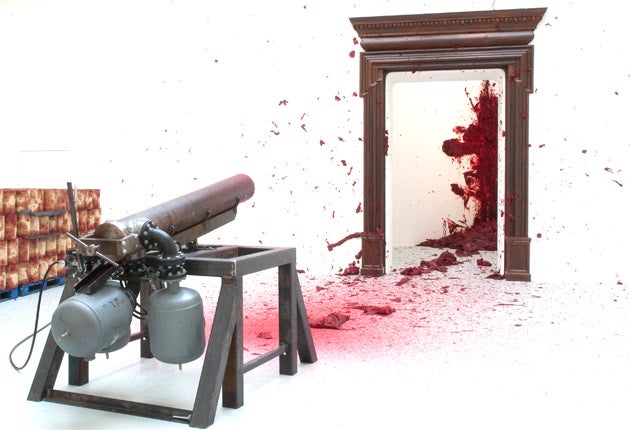Anish Kapoor, Royal Academy, London

Your support helps us to tell the story
From reproductive rights to climate change to Big Tech, The Independent is on the ground when the story is developing. Whether it's investigating the financials of Elon Musk's pro-Trump PAC or producing our latest documentary, 'The A Word', which shines a light on the American women fighting for reproductive rights, we know how important it is to parse out the facts from the messaging.
At such a critical moment in US history, we need reporters on the ground. Your donation allows us to keep sending journalists to speak to both sides of the story.
The Independent is trusted by Americans across the entire political spectrum. And unlike many other quality news outlets, we choose not to lock Americans out of our reporting and analysis with paywalls. We believe quality journalism should be available to everyone, paid for by those who can afford it.
Your support makes all the difference.The silliest work in the Anish Kapoor exhibition is a kind of shooting range. A cannon is aimed through one of the Royal Academy's ornate doorways. (The public are safely held back.) Every 20 minutes, an operator loads it with a bucketful of deep red gunk. It fires. The gunk hits the wall through the doorway, dribbles down, piling up at the bottom, with much spatter. This will accumulate over the next three months.
It's silly because it's an unhappy mixture of solemn and fun. You have the severe sensory purity of an intense single colour – against the merriment of guns, bangs, splats, sticky mess all over. Kapoor's work has always been on the edge of entertainment, even as it's tempted to high and grand pretension.
His earliest signature sculptures from the early 80s were geometrical solids on the floor, covered in powdered pigments. Their colours were so intense, your eye lost its grip on their volumes. It's good to see these small, dazzling objects again. This isn't a retrospective, but there's enough here to remind you of Kapoor's powers as an illusionist. He's invented some very original optical tricks.
There are the works using concavities and convexities, hollows and bulges whose curvatures are so smooth it's easy for them to disappear into the wall. He's done some classy distorting mirrors too, in which both the viewer and the mirror seem to leave gravity behind.
My favourite illusions – none here, I'm sorry to say – are the ones where an oblong is cut into a wall, and the inside space is painted so dark that it recedes into unfathomable depths. But then, seen another way, the depths come smartly up to the surface, and what you see is simply an oblong, painted flat onto the wall. Delightful!
These hallucinatory effects have tempted many people to find spirituality. We take sensory disorientations as a glimpse of the beyond, and Kapoor's titles haven't discouraged that. Equally, he's brought in a sense of the flesh, with strong carnal reds and blatant sexual symbolism (holes, protuberances), building up a vocabulary of "universals" – body and spirit, male and female, earth and heaven. The sex-symbolism can be terrible. See the writhing serpentine form that ends in a big red lipsticked vagina-mouth.
And lately Kapoor's art has been drawn, not only to illusion and symbolism, but to big spectacle. The result is generally vanity. In the RA's forecourt, a 15-metre column stands, made of 75 mirror-spheres, reflecting themselves and their surroundings – an executive toy, vastly enlarged.
Inside, another work occupies five continuous galleries, the whole width of the RA's exhibition space. This is more worth looking at. It's hard to describe. More deep red gunk is involved. A rail track runs through the galleries. A kind of train, more like a huge loaf, travels along it, narrowly passing through the arched doorways. It creeps slowly, barely moving. The track is filled with gunk, the doorways are rimmed in it, the train is a solid block of it, shaped by being forced through those arches.
This is an extraordinary spectacle. The thing I call a train, it isn't really like a train or a loaf. The red gunk doesn't really suggest blood. The way the train inches through the doorways, leaving a scraped ridge of gunk, it's not penetration. I don't know what it's like.
And it's a good thing about this work, that it's hard to imagine just what corner of culture or the artist's mind it came from. (It's title is Svayambh, Sanskrit for self-generated.) But beyond that, for something so strange and big, it ought to be amazing. It isn't. It's just strange and big. A deep red elephant.
But there's something else to see here, neither grand nor tricksy. What is it like? It's a room full of sandcastles, grey sandcastles made from fat sandworm casts. These mounds of matter are viscous and coiled, squeezed out of a tube, wriggling and woven. It's like something evolving and fabricated, and – a stranger in this company – a perfectly serious piece of sculpture.
To 11 December (0844 209 1919)
Join our commenting forum
Join thought-provoking conversations, follow other Independent readers and see their replies
Comments